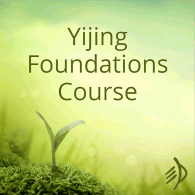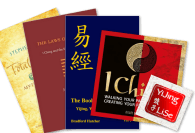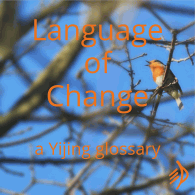One of the fascinating things about the structure of the Yijing is the way one hexagram in a pair (an odd-numbered hexagram with the even-numbered one that follows it, that is) can point to the other. It might contain it, or imply it, or give you a different perspective on it, like looking at the same scene through a different window. (An obvious example – in Hexagram 51, Shock, someone is not losing the ladle and libation: he represents the qualities of Hexagram 52, Stilling.)
Hexagram 61, Inner Truth, says that it is fruitful to cross the great river. The Tuanzhuan, the Commentary on the Judgement, adds,
‘Fruitful to cross the great river,
Riding a wooden boat’s emptiness.’
Your inner truth will move you to cross into new landscapes, and inner space is the vehicle that will carry you there; it is the boat’s emptiness that lets it float across the river. The shape of the hexagram itself –

– suggests the boat seen from above, or the inner structure of the hollow bamboo poles bound together to create it.
There seem to be echoes of the Daodejing –
‘The thirty spokes unite in the one nave; but it is on the empty space (for the axle), that the use of the wheel depends. Clay is fashioned into vessels; but it is on their empty hollowness, that their use depends. The door and windows are cut out (from the walls) to form an apartment; but it is on the empty space (within), that its use depends.’
(Legge’s translation)
The inner space makes you capable of the transition; the conviction of inner truth naturally wants to be translated into steady movement –
‘Inner Truth means constancy bears fruit,
Hence being in accord with Heaven.’
Much as Hexagram 30 means not just a spark of insight but a steady light, so Inner Truth will translate a momentary awareness (a timeless one, perhaps) into a way of being. The name of the hexagram is strongly ‘vertical’: zhong, ‘inner’ and ‘central’, shows a vertical line bisecting a square, probably representing a pole with a drum mounted on it: 中. And fu, ‘truth’ and ‘confidence’, shows a bird’s claw coming down to cover a young one: 孚. Then the text shows how this vertical axis can be transposed into horizontal movement – the journey across the river, constancy, trustworthiness over time.
And so Hexagram 62 follows
– and the inner space has become inner animation and movement.
![]()
Or as the Sequence says,
‘To have trust naturally means acting on it, and so Small Exceeding follows.’
‘Exceeding’ means crossing over a line, making a transition. First you experience a truth inwardly, and then it becomes a message to carry safely out into the world. A flying bird (perhaps not unrelated to the young one in fu or the young crane in 61, line 2) shows you how.








